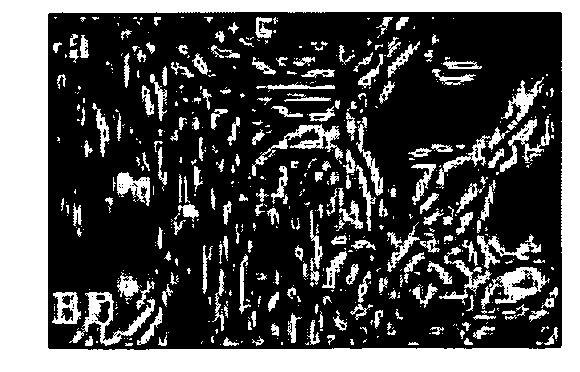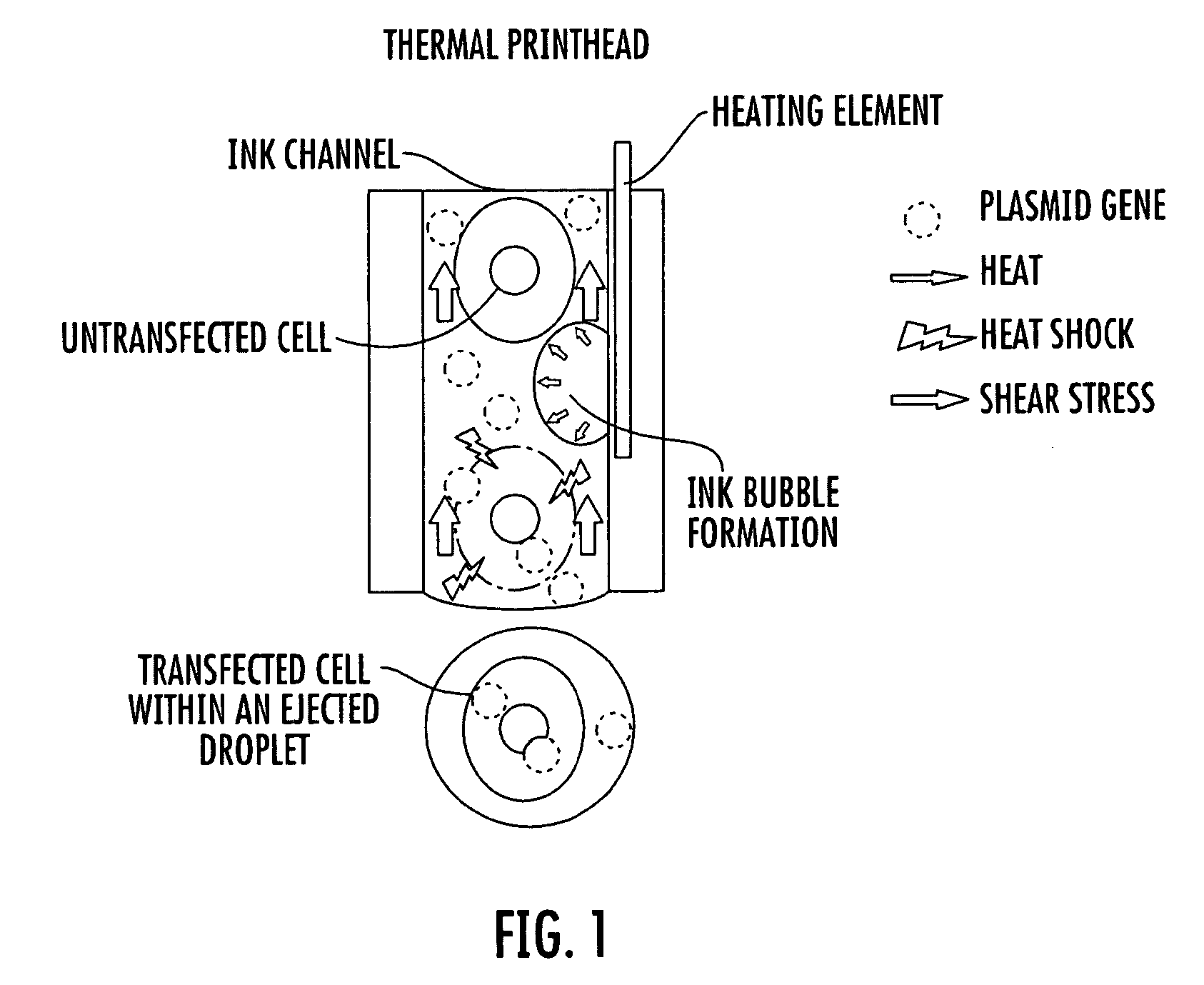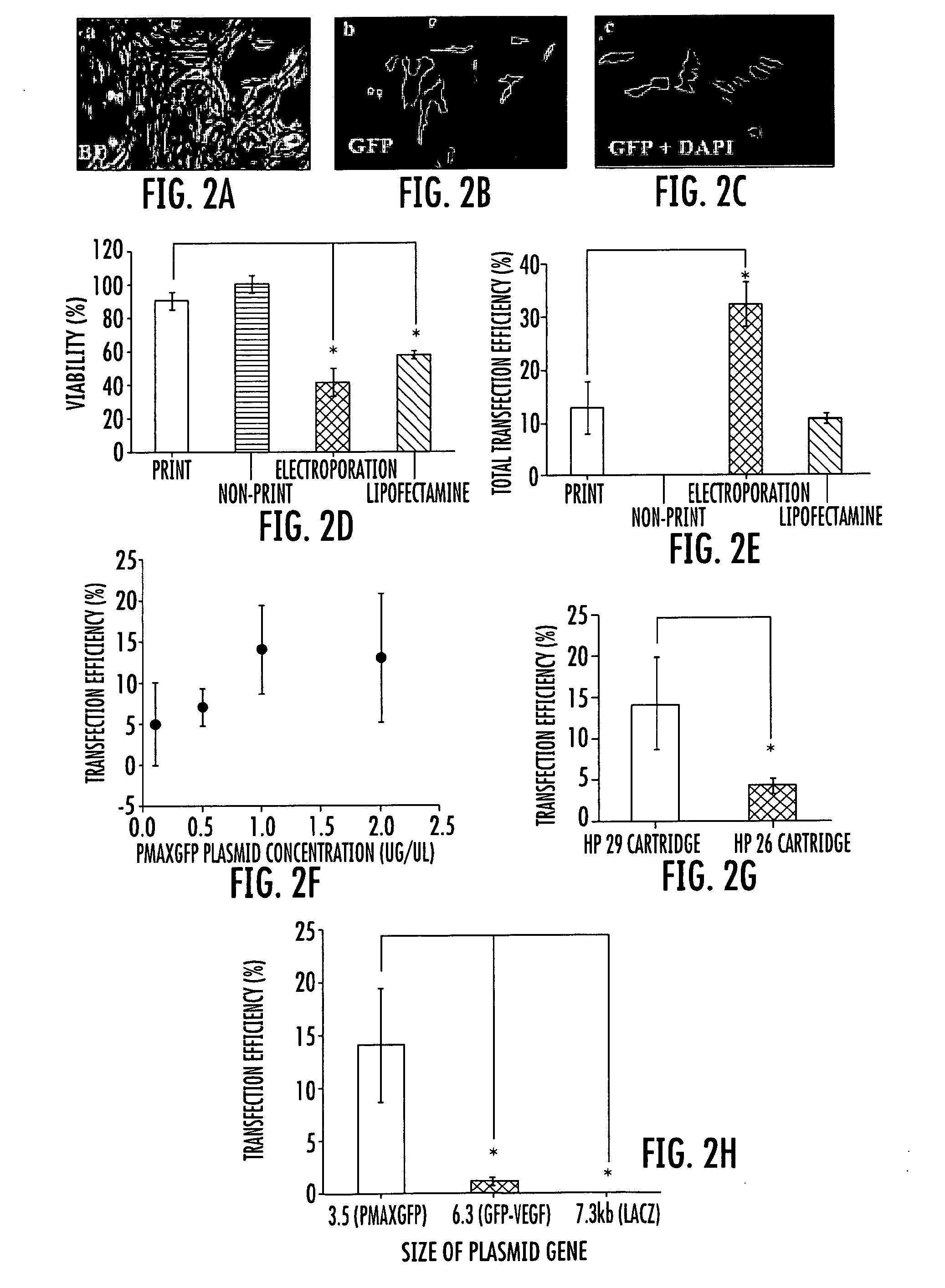Inkjet gene printing
a gene printing and inkjet technology, applied in the field of inkjet gene printing, can solve the problems of unsatisfactory tissue engineering application of existing techniques, unsuitable for studies, and ineffectiveness,
- Summary
- Abstract
- Description
- Claims
- Application Information
AI Technical Summary
Benefits of technology
Problems solved by technology
Method used
Image
Examples
example 1
[0070]In vitro transfection by coprinting. A porcine aortal endothelial cell line (PAEC) was used, which was established previously in our lab by enzymatic dispersion of adult pig aorta, and the passage 15, 16 and 17 of the cell line were used for gene transfection. PAEC cells were maintained in F12 medium (GIBCO, Invitrogen, Carlsbad, Calif.) supplemented with 10% fetal bovine serum (GIBCO), and 100 IU penicillin and 100 mg / ml streptomycin at 37° C. in a humidified 5% CO2 (95% air) atmosphere.
[0071]Cytomegalovirus (CMV) early immediate promoter driven plasmids encoding the cDNAs were used. The pmaxGFP™ (Amaxa GmbH, Germany, and Gaithersburg, Md.), pIRES-VEGF-GFP (BD Biosciences, Bedford, Mass.), and pIRES-lacZ (BCCM / LMBP, Belgium) plasmids were each amplified in DH5a strain of Escherichia coli, isolated by alkaline lysis, and purified by ion exchange column chromatography (Qiagen Inc., Valencia, Calif.). The pmaxGFP™ plasmid encodes the green fluorescent protein (GFP) from the cope...
example 2
[0076]Comparison with common transfection methods. We further compared the cell viability and the transfection efficiency of the inkjet printing method with other chemical and physical transfection methods commonly used in tissue engineering. For this purpose, a common liposome based agent and an electroporation approach were performed. Lipofectamine™ 2000 (Invitrogen), a common liposome based agent, and Nucleofection, an electroporation approach, were compared to the printing method using the PAEC cell cultures.
[0077]For transfection with Lipofectamine™ reagent, PAEC cells were seeded in a 24-well plate at a density of 2×105 cells per well the day before transfection. Transfection was performed according to the manufacturer's protocol. Briefly, 0.8 μg pmaxGFP™ (Amaxa) and the equivalent amount of Lipofectamine™ 2000 reagent were each added to 50 μl of serum free F12 medium. After incubation for 5 min at room temperature (RT), they were mixed and further incubated for 20 min at room...
example 3
[0086]Comparison of ink cartridges, concentration and size of plasmid. Different HP cartridges were also tested for inkjet gene transfection. The HP 51629a cartridge demonstrated higher gene transfection efficiency than the HP 51626a cartridge, as shown in FIG. 2g. The HP 51629a and HP 51626a cartridges share many similar printing parameters and mechanisms, but differ in the nozzle size. It is believed that the HP 51629a cartridge has a relatively smaller nozzle diameter than the HP 51626a cartridge, which may cause the higher stress, thus leading to higher transfection efficiency. After trypsin treatment, PAEC cells are about 10-20 μm. The nozzles of the HP 51629a and HP 51626a cartridges are about 40 and 50 micrometers, respectively (see Xu et al., Biomaterials (2006) 27(19):3580-88).
[0087]It was also found that several other factors could affect the transfection. Different concentrations of the plasmids in the print suspension were tested. As shown in FIG. 2f, the gene expression...
PUM
| Property | Measurement | Unit |
|---|---|---|
| time | aaaaa | aaaaa |
| diameter | aaaaa | aaaaa |
| diameter | aaaaa | aaaaa |
Abstract
Description
Claims
Application Information
 Login to View More
Login to View More - R&D
- Intellectual Property
- Life Sciences
- Materials
- Tech Scout
- Unparalleled Data Quality
- Higher Quality Content
- 60% Fewer Hallucinations
Browse by: Latest US Patents, China's latest patents, Technical Efficacy Thesaurus, Application Domain, Technology Topic, Popular Technical Reports.
© 2025 PatSnap. All rights reserved.Legal|Privacy policy|Modern Slavery Act Transparency Statement|Sitemap|About US| Contact US: help@patsnap.com



